SUPERCHARGE YOUR ONLINE VISIBILITY! CONTACT US AND LET’S ACHIEVE EXCELLENCE TOGETHER!
In the dynamic world of search engine optimization (SEO), staying ahead of the competition requires the implementation of advanced strategies and tactics. This guide delves into three indispensable SEO techniques essential for enhancing your campaign’s success. From optimizing source code and analyzing low click-through rates (CTR) to leveraging the Keyword Golden Ratio (KGR) method, these tactics can significantly improve your website’s visibility and search engine rankings. By implementing these strategies, you can better understand your audience, optimize your content, and enhance your overall SEO performance.

Why is Custom Source Code Search an effective SEO tactic?
Custom source code search is an effective SEO tactic that offers several advantages for optimizing your website’s performance and visibility. Here are several important reasons why it is advantageous:
- Identifies Code Issues: Custom source code search helps identify errors in your website’s code, such as missing tags, incorrect syntax, or outdated scripts, which may affect your site’s performance and search engine rankings.
- Ensures Compliance: By checking your website’s source code for compliance with SEO best practices, you can ensure your site meets search engine guidelines and avoids penalties.
- Locates Tracking and Analytics Scripts: Custom source code search allows you to verify the presence of essential tracking and analytics scripts, such as Google Analytics, Google Tag Manager, and other monitoring tools, ensuring accurate data collection.
- Detects Inconsistent Implementations: This tactic can identify inconsistencies in code implementation across different pages, helping you maintain a consistent user experience and enhance crawlability.
- Improves Page Load Times: By pinpointing unnecessary scripts and bloatware, you can streamline your codebase and improve page load times, enhancing both user experience and SEO.
- Facilitates Structured Data Implementation: Custom source code search can verify the correct use of structured data, such as schema markup, which improves your site’s search engine understanding and can lead to rich snippets in search results.
By regularly performing custom source code searches, you can maintain a clean, efficient, and optimized website that adheres to SEO best practices and delivers an enhanced user experience.
Why is CTR analysis an SEO tactic?
- Identifies Underperforming Pages: CTR analysis helps you pinpoint which pages on your site are receiving impressions but not converting those impressions into clicks. This indicates opportunities for improvement.
- Optimizes Title Tags and Meta Descriptions: Low CTR can suggest that your title tags and meta descriptions aren’t compelling enough. By improving these elements, you can increase the likelihood of clicks.
- Guides Content Strategy: Understanding which pages have low CTR helps you adjust your content strategy to create more engaging and relevant content that aligns with user intent.
- Enhances User Experience: By analyzing low CTR pages, you can make adjustments to better meet users’ expectations, thereby improving their experience and increasing the chances of them engaging with your content.
- Increases Search Engine Rankings: Higher CTR can positively impact search engine rankings, as it signals to search engines that your content is relevant and valuable to users.
- Boosts Conversion Rates: Improved CTR can lead to more conversions as users engage more with your content and follow through with actions such as purchases or sign-ups.
- Provides Insight into Market Trends: Tracking CTR over time can give you insights into market trends and user preferences, allowing you to tailor your content to current demands.
Why is the Keyword Golden Ratio (KGR) method an SEO tactic?
The Keyword Golden Ratio (KGR) method is an effective SEO tactic for several reasons:
- Targets Low-Competition Keywords: KGR helps you find and target low-competition keywords with high-ranking potential. By focusing on these keywords, you increase your chances of ranking well in search engine results.
- Accelerates Ranking: Pages targeting KGR keywords often see quick results, as they face less competition. This can help you achieve higher rankings and drive traffic to your site faster.
- Optimizes for Long-Tail Keywords: The KGR method typically involves targeting long-tail keywords, which tend to be more specific and cater to niche audiences. This can improve user engagement and conversion rates.
- Improves Content Relevance: By focusing on low-competition, high-relevance keywords, you can create content that aligns closely with user intent, leading to better user satisfaction and engagement.
- Guides Content Creation: KGR provides a structured approach to content creation, helping you develop topics that have a higher chance of ranking and attracting organic traffic.
- Helps You Stay Ahead of Competitors: Since KGR focuses on less competitive keywords, it allows you to carve out a niche in your industry and stay ahead of competitors who may be targeting more general or oversaturated terms.
The KGR method is an efficient SEO strategy that helps you target niche, low-competition keywords for improved search engine rankings and better content performance. By incorporating this tactic into your SEO efforts, you can achieve quicker and more sustainable results.
⭐️How To Do Custom Source Code Search
Check the following steps to search custom source code
1) Add Custom Search Filters
Click ‘Configure > Custom > Search’ from the top-level menu to open the custom search configuration.
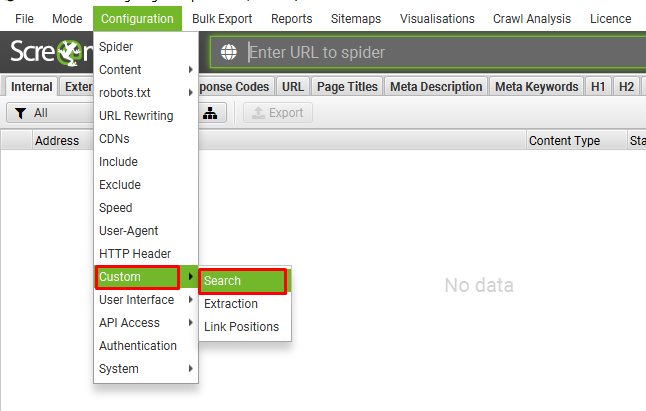
Then click ‘Add’ (in the bottom right) to set-up a custom search filter.
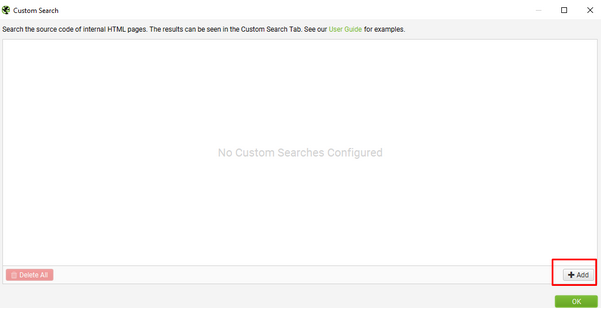
A custom search filter will appear.
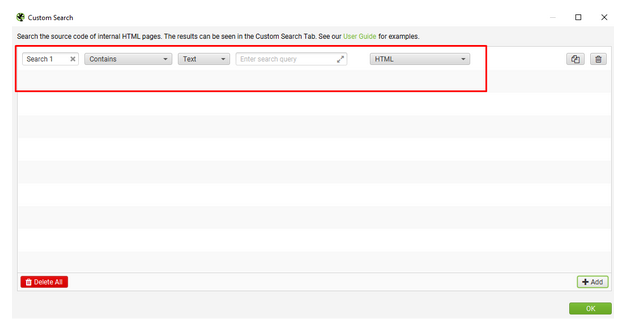
2) Input Your Search
Now enter search in the ‘Enter Search Query’ box and adjust each search filter option.
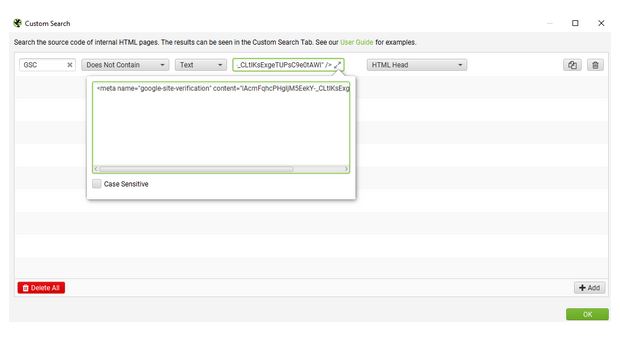
From left to right, any name can be given the search filter, then select either ‘contains’ or ‘does not contain’, then choose either ‘text’ or ‘regex’,
And then input the search query. Here, google search console query has been used, Google analytics, google tag manager, structure data, etc code can be used.
When the filters are set-up, then click ‘OK’ and run a crawl to perform the search.
3) Crawl The Website
After the custom search set up, crawl the website
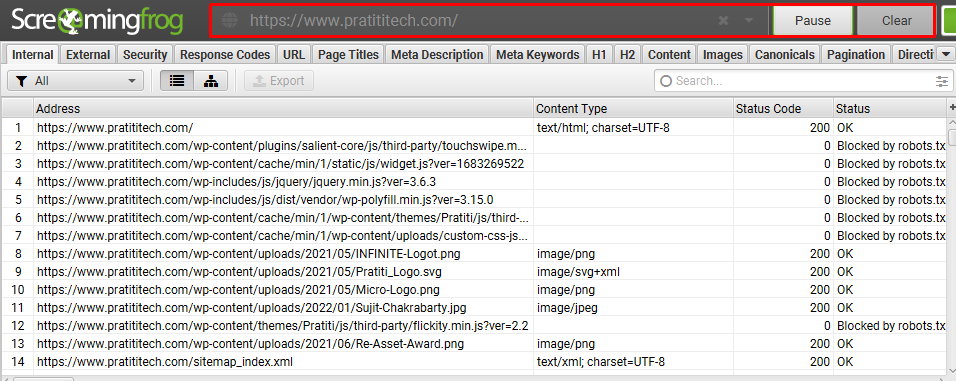
4) View Data In The Custom Search Tab & Filters
Click on the Custom Search tab to view the results of custom search in real-time.
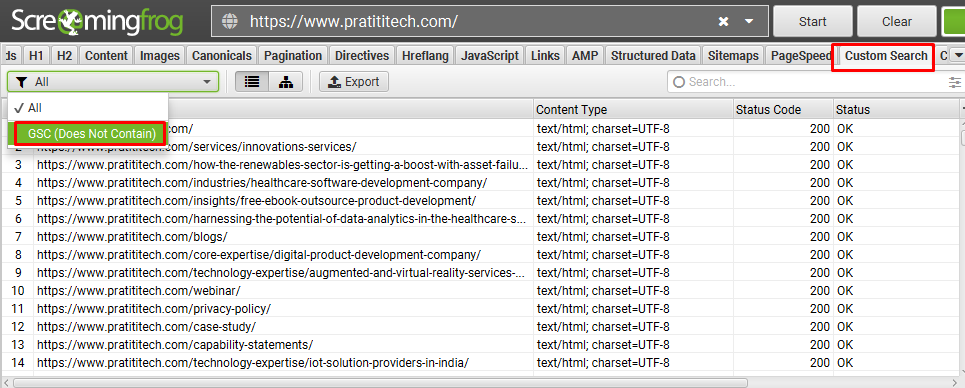
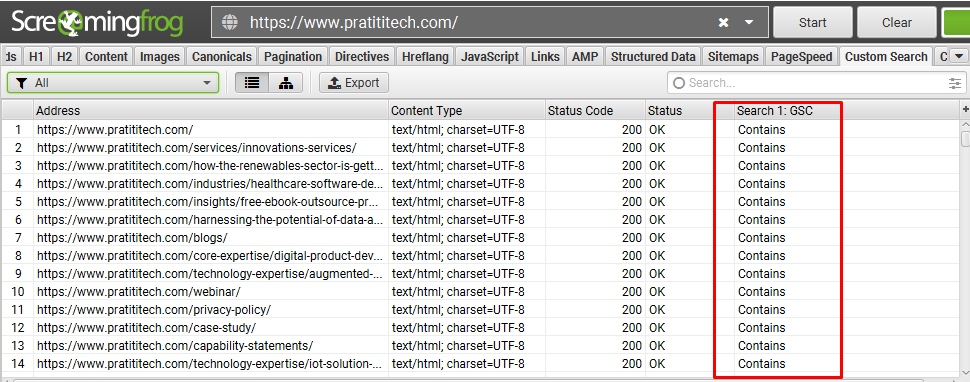
And here we can see that all the pages contain google search console code.
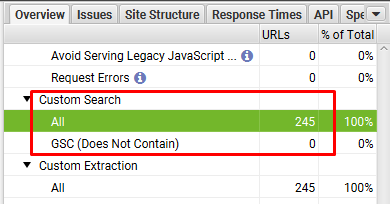
So no other page is not under the “Does not contain” category.
If any search category is found “does not contain” of any page, then export those pages, and put the code on the page backend.

⭐️Low CTR Page Analysis
Procedure:
- Go To Google Search Console.
- Performance > Pages > Filter by Average CTR.
- Highlight the low CTR Pages:
Click-through rate (CTR) is the ratio of the number of clicks on a specific link or call to action (also known as CTA, for example the ‘Learn more’ text at the bottom of an email marketing campaign) to the number of times people were exposed to the link (aka the number of impressions).
Current observation:
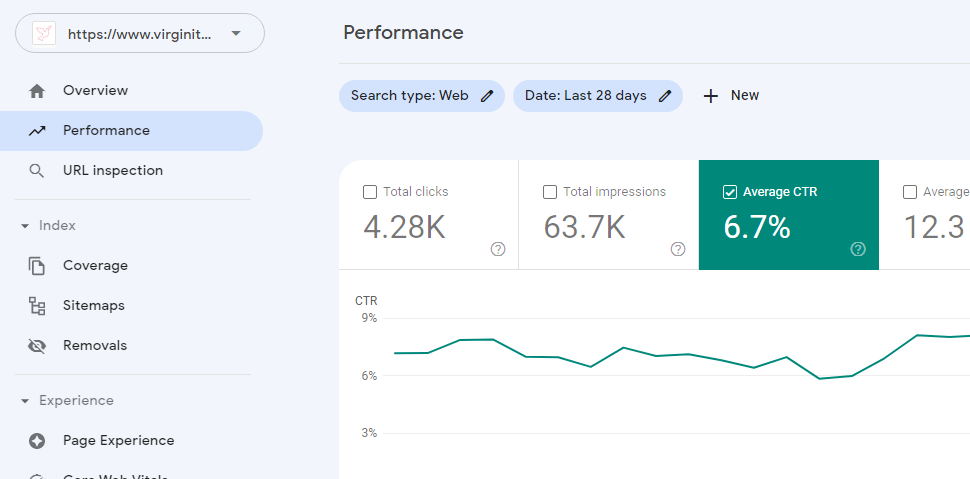

Here are four tips to consider when you’re trying to improve CTR:
1) Optimize your headline and copy:
Use one or two focus keyword(s) in your headline and copy. Appeal to your audience’s emotions and needs: solve a problem for them.
2) Include CTAs:
Write a direct and compelling call to action. Your CTA should be inviting and prompt your audience to click.
3) Use images:
Using visuals is a great way to increase CTR. Depending on the marketing channel, different types of images may perform better than others. Run A/B tests with different types of images to find out what works best for your company.
4) Try using hashtags:
Hashtags work across multiple platforms, like Facebook, Twitter, and LinkedIn. Do some research on trending or popular hashtags in your industry, and use hashtags that relate to the rest of your copy to increase the chances of being seen by your target audience.
⭐️KGR keywords Finding
What is KGR keyword?
KGR (Keyword Golden Ratio) is a method used in SEO to determine the competition level of a specific keyword. It involves dividing the number of Google search results by the monthly search volume, with a result of less than 0.25 considered a good keyword to target. This method is useful for finding low-competition, long-tail keywords with a higher chance of ranking on the first page of search results.
How to find KGR keyword?
The number of Google results that have the keyword phrase in the title divided by the monthly search volume, where the search volume is less than 250. If the KGR is less than 0.25, then you should rank in the top 50 as soon as your page is indexed.
Search Result:
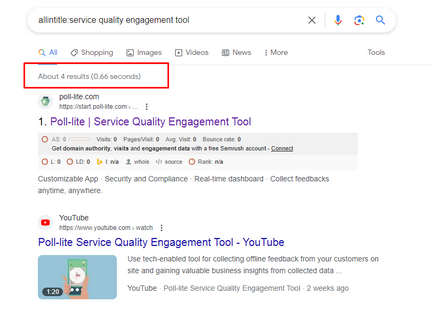
Monthly Search Volume:

KGR keyword formula:
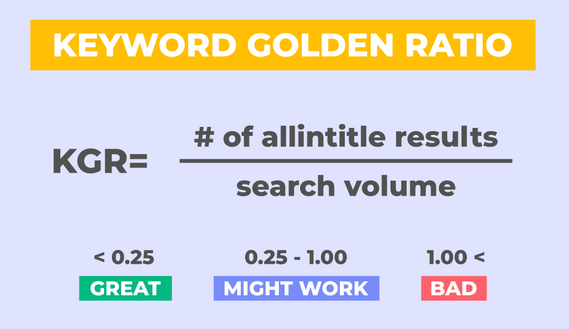
Allintitle result (4) / Search volume (50) = 0.08 (<0.25)
So, it can be a pretty good KGR keyword. And it can rank as soon as the keyword gets indexed.

